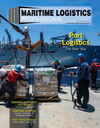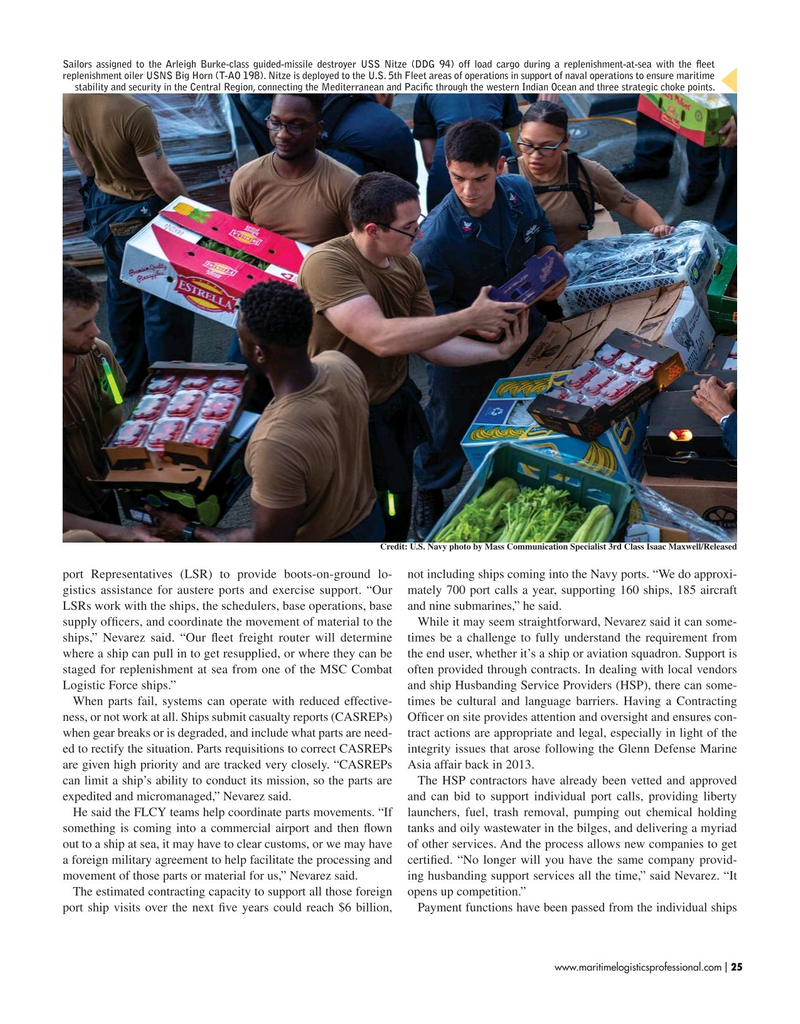
Page 25: of Maritime Logistics Professional Magazine (May/Jun 2019)
US and International Navy Ports
Read this page in Pdf, Flash or Html5 edition of May/Jun 2019 Maritime Logistics Professional Magazine
Sailors assigned to the Arleigh Burke-class guided-missile destroyer USS Nitze (DDG 94) off load cargo during a replenishment-at-sea with the feet replenishment oiler USNS Big Horn (T-AO 198). Nitze is deployed to the U.S. 5th Fleet areas of operations in support of naval operations to ensure maritime stability and security in the Central Region, connecting the Mediterranean and Pacifc through the western Indian Ocean and three strategic choke points.
Credit: U.S. Navy photo by Mass Communication Specialist 3rd Class Isaac Maxwell/Released port Representatives (LSR) to provide boots-on-ground lo- not including ships coming into the Navy ports. “We do approxi- gistics assistance for austere ports and exercise support. “Our mately 700 port calls a year, supporting 160 ships, 185 aircraft
LSRs work with the ships, the schedulers, base operations, base and nine submarines,” he said.
supply of?cers, and coordinate the movement of material to the While it may seem straightforward, Nevarez said it can some- ships,” Nevarez said. “Our ?eet freight router will determine times be a challenge to fully understand the requirement from where a ship can pull in to get resupplied, or where they can be the end user, whether it’s a ship or aviation squadron. Support is staged for replenishment at sea from one of the MSC Combat often provided through contracts. In dealing with local vendors
Logistic Force ships.” and ship Husbanding Service Providers (HSP), there can some-
When parts fail, systems can operate with reduced effective- times be cultural and language barriers. Having a Contracting ness, or not work at all. Ships submit casualty reports (CASREPs) Of?cer on site provides attention and oversight and ensures con- when gear breaks or is degraded, and include what parts are need- tract actions are appropriate and legal, especially in light of the ed to rectify the situation. Parts requisitions to correct CASREPs integrity issues that arose following the Glenn Defense Marine are given high priority and are tracked very closely. “CASREPs Asia affair back in 2013. can limit a ship’s ability to conduct its mission, so the parts are The HSP contractors have already been vetted and approved expedited and micromanaged,” Nevarez said. and can bid to support individual port calls, providing liberty
He said the FLCY teams help coordinate parts movements. “If launchers, fuel, trash removal, pumping out chemical holding something is coming into a commercial airport and then ?own tanks and oily wastewater in the bilges, and delivering a myriad out to a ship at sea, it may have to clear customs, or we may have of other services. And the process allows new companies to get a foreign military agreement to help facilitate the processing and certi?ed. “No longer will you have the same company provid- movement of those parts or material for us,” Nevarez said. ing husbanding support services all the time,” said Nevarez. “It
The estimated contracting capacity to support all those foreign opens up competition.” port ship visits over the next ?ve years could reach $6 billion, Payment functions have been passed from the individual ships www.maritimelogisticsprofessional.com 25
I

 24
24

 26
26
